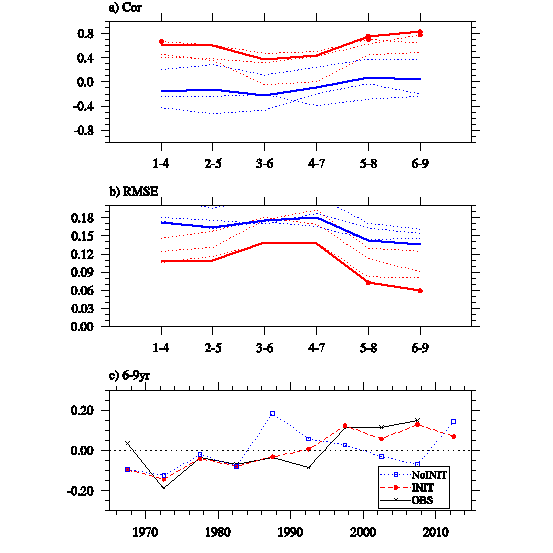Significant Predictive Skills Were Shown in the Decadal Prediction System Developed by the Institute of Atmospheric Physics
Date:2015-09-16
As the forefront of international scientific research, decadal prediction has become a hot research area in the climatology. Decadal prediction focuses on the climate changes in the next 10-30 years. On the time scale, the contributions of internally generated variability to the climate change is close to those of the external forcing. Hence, it is very difficult to improve the predictive skills. The core issue of the decadal prediction is how to initialize coupled climate model to obtain accurate initial conditions for the prediction of the internal variability. The decadal prediction experiment has become one of the core experiments in the Coupled Model Intercomparison Project Phase 5 (CMIP5), and will be carried on in the CMIP6.
Recently, Dr. WU Bo et al. from the Institute of Atmospheric Physics published decadal prediction results by the coupled global climate model FGOAL-s2. The decadal prediction system was initialized by assimilating upper 1000m oceanic temperate and salinity anomalies based on the incremental analysis update (IAU) scheme. Systematic hindcast runs were conducted and compared with the observation and convential historical runs.

Fig. 1 Hindcast qualities of the the Atlantic multi-decadal oscillation index, which is defined as area-averaged SST anomalies in the 0°-60 °N, 80°-0°W minus the area-averaged near-global SST anomalies in the 60 °S–60 °N. a) Correlations between the model runs and the observational references along the forecast time for 4-year averages. The red (blue) lines denote INIT (NoINIT) runs. The dashed (solid) lines denote ensemble members (means). The dots represent that corresponding correlation coefficients reach the 5% significance level based on the one-sided student’s t test. b) RMSE of the model runs along the forecast time for 4-year averages. Dots are used when RMSE of the ensemble mean of the INIT runs are statistically significant less than those of the ensemble mean of the NoINIT runs at 5% level, based on the one-sided F test. c) Time series of the AMO indices predicted by the ensemble mean of the INIT (NoINIT) runs for predictions averaged over the hindcast years 6-9 and corresponding observational reference (units: K). d) As in c), but for hindcast years 1-4.
The results show that the predictive skills of the hindcast runs in the Atlantic multi-decadal oscillation (AMO) are significantly higher than the uninitialized historical runs (Fig.1). The improvement in the predictive skills is mainly because the hindcast runs can reproduce the interdecadal variability of the northward heat transport associated with the change of the Atlantic meridional overturning circulation (AMOC). In addition, the decadal prediction experiments by FGOALS-s2 showed high skills in the Indian Ocean and western Pacific. This work established the foundation for the further development of the decadal prediction system in the LASG/IAP.
Citation: Bo Wu, Xiaolong Chen, Fengfei Song, Yong Sun, and Tianjun Zhou, 2015,Initialized Decadal Predictions by LASG/IAP Climate System Model FGOALS-s2: Evaluations of Strengths and Weaknesses, Advances in Meteorology, vol. 2015, Article ID 904826, 2015. doi:10.1155/2015/904826.
Contact: Dr. WU Bo, wubo@mail.iap.ac.cn
